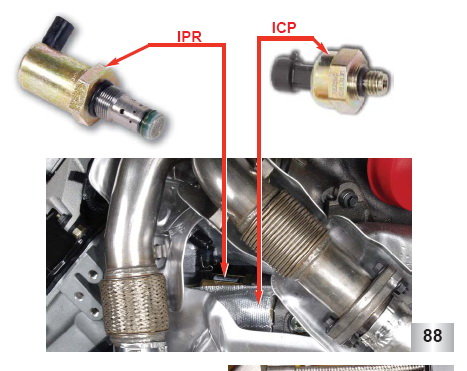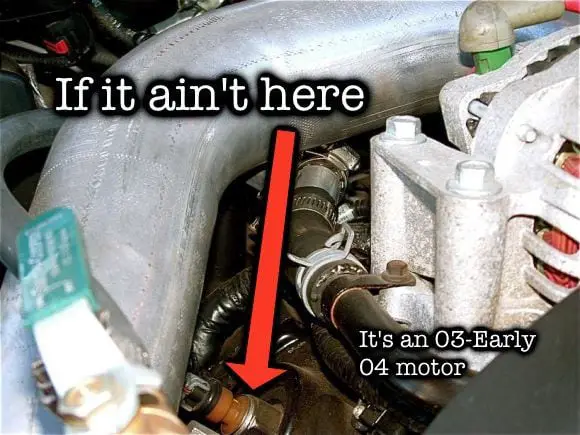Icp 6.0 Powerstroke Location: Expert Tips for Precision.
When it comes to the performance of your Ford Powerstroke engine, the location of the Injection Control Pressure (ICP) sensor plays a crucial role. Understanding where this sensor is located can help you diagnose issues and ensure your truck runs smoothly.
What is the ICP Sensor?
The ICP sensor is responsible for monitoring the pressure of the engine’s oil that is being supplied to the fuel injectors. This information is crucial for the engine control module to adjust fuel delivery and optimize engine performance.
Locating the ICP Sensor on Different 6.0 Powerstroke Models (Early vs. Later):
The elusive ICP sensor on your 6.0 Powerstroke can be like a hidden treasure – its location depends on the year of your truck. Here’s a breakdown to help you find it:
Early Treasure Hunt (2003-Early 2004 Models):
For these early adventurers, the ICP sensor is tucked away in a bit of a challenging spot: underneath the turbocharger, near the y-pipe flange. This means you’ll likely need to spend some quality time under the hood, maneuvering around various components (be sure to prioritize safety with proper ramps or jack stands).download
Treasure Chest Revealed (Late 2004-2007 Models):
Good news for later model owners! The ICP sensor location becomes significantly more accessible. You’ll find it on the passenger side valve cover, above the Low Pressure Control Module (LPCM). This translates to a much easier replacement process, as you won’t have to wrestle with the tight confines near the turbocharger.download
A Word on Variations:
It’s important to note that there might be slight variations in ICP sensor placement depending on specific engine configurations or aftermarket modifications. If you have any doubts about your specific model, consulting a repair manual or trusted mechanic can be helpful.

Symptoms of a Faulty ICP Sensor: Uh Oh, Is My 6.0 Powerstroke Talking Trouble?
A faulty ICP sensor can throw your 6.0 Powerstroke’s performance into a tailspin. Here’s what to watch out for:
1. Engine Acting Up:
- Rough Idle: A normally smooth idle can become erratic or shaky with a bad ICP sensor. The engine might vibrate excessively, making your ride less than comfortable.
- Hesitation and Stumbling: Acceleration might become sluggish, and you might experience hesitation or stumbling when pressing the gas pedal. This can be frustrating and unpredictable during everyday driving.
2. Power Loss Like a Deflated Balloon:
One of the most noticeable symptoms is a decrease in overall power output. Your 6.0 Powerstroke might feel sluggish and unresponsive, struggling to deliver the power you’re accustomed to.
3. Warning Lights Flashing SOS:
Your instrument cluster might light up like a disco ball with a faulty ICP sensor. Keep an eye out for:
- Check Engine Light: This is a general indicator of an issue, and a bad ICP sensor can trigger it.
- Wrench Light: This light specifically points towards potential problems within the engine’s electronic control system, which can include the ICP sensor.
Don’t Ignore the Signs!
These symptoms can be individually caused by other issues, but their combined presence suggests a potential problem with the ICP sensor. If you experience any of these signs, it’s crucial to address them promptly to avoid further complications within your 6.0 Powerstroke’s engine.
Where to Find the ICP Sensor?
If you are wondering where the ICP sensor is located in your Ford Powerstroke engine, here are some common locations:
| Location | Description |
|---|---|
| Passenger Side Valve Cover | Located on the front of the passenger side valve cover |
| Behind Turbocharger | Behind the turbocharger and beneath the turbocharger up-pipe collector |
| Drivers Side | Accessible from under the truck on the drivers side or from the top if you have small hands |
| Mid-Line | Located at the back of the motor about mid-line |

Replacing the ICP Sensor: DIY or Dash to the Mechanic?
With a faulty ICP sensor diagnosed, the question arises: tackle the replacement yourself or entrust it to a professional? Here’s a breakdown to help you decide:
DIY Difficulty Level:
The difficulty of replacing the ICP sensor depends on your model year:
- Early 2003-Early 2004 Models (Under Turbocharger): This location is moderately challenging. Tight spaces and awkward angles require patience and some mechanical know-how.
- Late 2004-2007 Models (Passenger Side Valve Cover): This placement is significantly easier. The sensor is readily accessible, making the replacement a more DIY-friendly task.
Tools You’ll Need:
- Set of wrenches (various sizes)
- Socket set (including an extension for early models)
- Oil drain pan (for catching any spilled oil)
- Replacement ICP sensor (ensure it matches your specific engine year/model)
- Rags (for cleaning)
Steps Involved (General Guidance):
- Safety First: Park your truck on a level surface, engage the parking brake, and disconnect the negative battery terminal.
- Locate the sensor: Refer to the previous section to identify the specific location based on your model year.
- Disconnect the electrical connector: Find the wiring harness connected to the ICP sensor and carefully unplug it.
- Loosen the sensor: Using the appropriate wrench or socket, loosen the nut or bolt securing the ICP sensor. Be prepared for a small amount of oil to drain out.
- Remove the old sensor: Once loose, unscrew the sensor by hand and carefully remove it.
- Install the new sensor: Screw in the new sensor by hand until snug. Then, tighten it further using your wrench/socket, but avoid overtightening.
- Reconnect the electrical connector: Plug the wiring harness back into the new sensor securely.
- Clean Up: Wipe away any spilled oil and dispose of the old sensor and used oil responsibly (check your local regulations).
- Reconnect the battery: Reattach the negative battery terminal.
Remember: These are general guidelines. For specific torque values or detailed instructions, consult a repair manual for your exact 6.0 Powerstroke model.
Proper Disposal Matters:
Used oil and automotive parts should never be discarded in regular trash. Find a designated collection center for used oil and parts recycling in your area to protect the environment.
When to Call in the Professionals:
If you’re uncomfortable with DIY repairs, tackling cramped spaces under the turbocharger, or lack the necessary tools, don’t hesitate to seek help from a qualified mechanic. They have the expertise and experience to handle the replacement efficiently.
Additional Tips and Considerations: Keeping Your 6.0 Powerstroke Running Strong
Replacing the ICP sensor can breathe new life into your 6.0 Powerstroke’s performance. Here are some additional points to consider:
Sensor Selection Matters:
- Match Your Model: It’s crucial to use the correct replacement sensor specifically designed for your engine year and model. A mismatch can lead to improper function or leaks. Double-check the part number before purchasing to ensure compatibility.
Upgrading for Potential Benefits:
- Aftermarket Options: The stock ICP sensor might be a known weak point for some 6.0 Powerstrokes. Consider exploring upgraded aftermarket sensors made from more durable materials. These might offer improved reliability and potentially extend the sensor’s lifespan.
Beyond the ICP Sensor:
While a faulty ICP sensor can cause various symptoms, it’s not always the sole culprit. Here are some other potential causes to consider if replacing the sensor doesn’t resolve the issues:
- High-Pressure Oil System Issues: The ICP sensor monitors the high-pressure oil system, so problems within this system can mimic a bad sensor. A mechanic can diagnose these more complex issues.
- Wiring Harness Faults: Damage or corrosion in the wiring harness connected to the ICP sensor can also lead to similar symptoms. A visual inspection can help identify any problems.
Consult a Professional When Needed:
If you’re unsure about the diagnosis or uncomfortable troubleshooting other potential causes, don’t hesitate to consult a qualified mechanic specializing in diesel engines. Their expertise can save you time and ensure your 6.0 Powerstroke gets the proper attention it deserves.
By following these tips and considerations, you can ensure a successful ICP sensor replacement and keep your 6.0 Powerstroke running smoothly for miles to come.
Frequently Asked Questions
Where Is The Icp Located On A 6.0 Powerstroke?
The ICP sensor on a 6. 0 powerstroke is located on the front of the passenger side valve cover. It can also be found behind the turbocharger and beneath the turbocharger up-pipe collector. Early warning signs of a failing ICP sensor include weak performance, rough idling, and difficulty starting.
Will An Icp Sensor Cause No Start?
Yes, a faulty ICP sensor can cause a no-start situation in your vehicle. Symptoms may include rough idling, stalling, or sputtering before it fails to start.
Where Is The Icp Sensor?
The ICP sensor is located on the front of the passenger side valve cover. It can also be found behind the turbocharger and beneath the turbocharger up-pipe collector. You can reach it from under the truck on the driver’s side or on top with small hands.
How To Tell If Icp Is Bad On 6.0 Powerstroke?
If your 6. 0 Powerstroke has a bad ICP, look out for weak performance, rough idling, stalling, or starting issues.
Conclusion
Knowing the location of the ICP sensor in your Ford Powerstroke engine is vital for maintaining optimal performance. Keep an eye out for signs of sensor failure and take the necessary steps to address any issues promptly. By understanding the role of the ICP sensor, you can ensure your truck runs smoothly for years to come.


